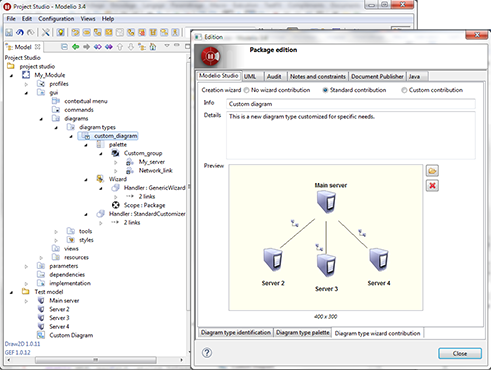
A user requirement describes a behavior or condition needed from an IT service in order to satisfy a concern. Next the BA registers all user requirements as children of concerns. It expresses what the business needs from an activity in order to mitigate a risk or to take advantage of an opportunity. A concern defines what the client, or the corporate sponsor, seeks to obtain for the business from the IT changes requested. The BA registers all business concerns as children of a specific activity.

#MODELIO TUTO HOW TO#
Video showing UML modeling and XMI import from Modelio to Leverforce:įor a detailed tutorial on how to set up a Modelio model to import UML elements to leverforce, view this link. Analyst can then import all elements in the model into the Leverforce database using the import XMI feature.īelow are two screenshots and a video showing how to import models using the open source Modelio modeler: The BA enters the use cases and activities that are relevant to the analysis into the Leverforce modules.To ease the entry of records, the BA is able to import the use cases and activities from excel/csv files.Įven simpler, and a more complete solution, the BA can use a UML modelling tool such as Modelio or EA Sparx to model use cases and activity diagrams. The BA also analyses all activities associated to each use case. While conducting interviews to gather business concerns and user requirements, the analyst narrows down a list of use cases in which the business will utilize the solution. The following video shows a basic project set-up: This is done through the standard CRM modules (Organization, Contacts, Projects). Step 1 Setting up a new project and business analysisīA sets up in Leverforce the client organization or internal business unit requesting the change in IT services. They also save the user time and reduce the physical strain on the hand for mouse guidance.This basic tutorial describes in 5 steps how our Business Analysts use Leverforce SAAS during the three phases of a project engagement: Business Analysis (Steps 1, 2, and 3) Project initiation (Step 4) and Commissioning (Step 5).

These interface enhancements significantly improve the ease of design and quality of rendering. If you are interested, contact us at This email address is being protected from spambots. SaaS customers will be able to benefit from this new version as soon as they wish. This new version of Modelio is now available. The modification of the links is now guided according to the vertical or horizontal axis with dynamic visual feedback, greatly facilitating the qualitative presentation of the model and reducing the effort required for guidance with the mouse. These points are called "user routing points" and they also benefit from dynamic visual feedback. When initially drawing a link or re-drawing it later, the user can now impose intermediate waypoints for the link. This dynamic visual feedback applies to the creation or modification of a link and its anchor. The new position of the links is displayed when the user moves the mouse and sees what the path will be.

This attachment established by the user will only be modified by an explicit action on his part. The new ergonomics ensure precise positioning and a simple and natural distribution of links on each side of the node. Regarding anchors and attachments, links are attached to nodes via anchors that are displayed when the link is created or manipulated. More intuitive and predictable, the new link management also improves visual feedback when creating or editing links.

Modelio 5.1 brings significant improvements to link management in BPMN diagrams, UML activity diagrams, UML state machine diagrams and ArchiMate views.


 0 kommentar(er)
0 kommentar(er)
